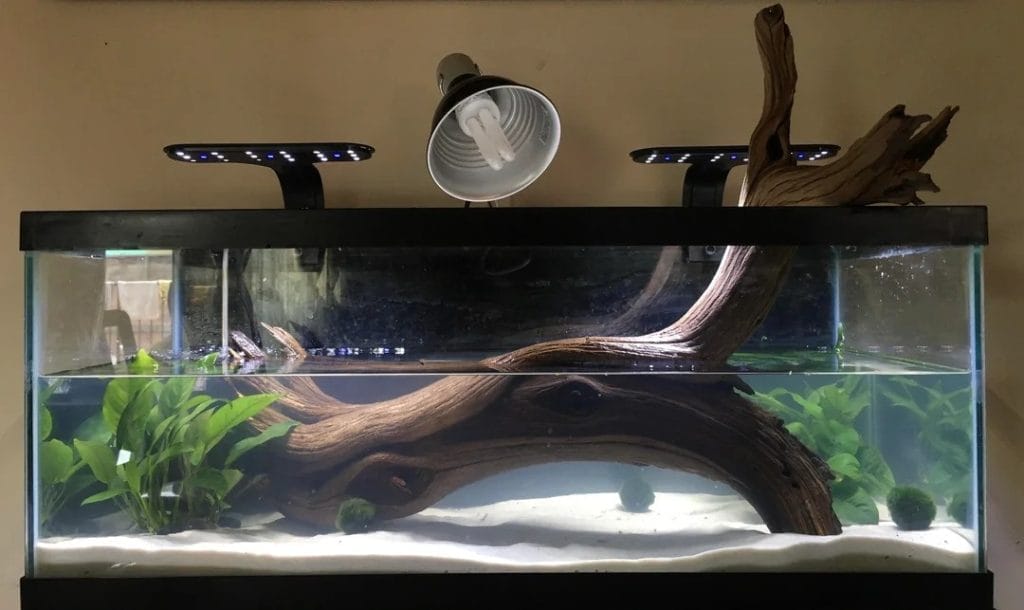How Far Do Sea Turtles Travel?

This post was created with help from AI tools and carefully reviewed by a human (Muntaseer Rahman). For more on how we use AI on this site, check out our Editorial Policy.
Sea turtles are the ancient mariners of the sea. They have survived in this world for 65 million years because they constantly move around to survive in the vast sea. Sea turtles begin their journey from birth and continue to travel until death. So, how far do sea turtles travel?
Sea turtles are famous for their migrating habits. They can travel thousands of miles in the sea in their lifetime. However, the migration for different sea turtles is not the same. Some travel far from their birthplace, others not so much.
In this article, I will talk about how far different species of sea turtles can travel and why they migrate so far away from the land. So, let’s dive in!
When Do Sea Turtles Begin Traveling?
As mentioned above, sea turtles are on the move although their life. Their lifelong journey begins with the first frenzied swim to the sea.
Thousands of female sea turtles come to the shore during the nesting season. They make nests, lay their eggs, and leave the spot as soon as the work is done. After a long incubation period, hatchlings emerge from the fertile eggs.
The land is not a safe place for sea turtle babies. So, right after birth, their instincts tell them to reach the sea. The first 48 hours starting from the emergence from the nest, is critical for baby sea turtles. While trying to reach the water, many hatchlings become victims of predators in the seashore.
After many hardships, the surviving sea turtle hatchlings reach the water. Unfortunately, even there, they face predators like dolphins, sharks, and killer whales. This way, about 50 to 60 percent of sea turtle babies and juveniles die every year. The rest of the sea turtles must constantly move around to stay safe in the sea.
Once the male sea turtles get into the sea, they never return to the land. But when the female hatchling mature, they return to their nesting place to lay their eggs.
Track A Real Sea Turtle With Each Bracelet!
Learn Name
You get to learn your sea turtle’s name, size, age. Also a picture!
Enjoy Stories
Enjoy the story of your sea turtle, where it came from, where is it going?
Follow Me
You get to follow the sea turtle’s journey on an interactive tracking map!
Click Here & Use Coupon Code: THETURTLEHUB20 For A 20% Discount!
How Far Do Sea Turtles Migrate?
Scientists can track how far a sea turtle migrates thanks to modern satellites. Sea turtles spend almost all of their life in the sea. They hunt, sleep, and even mate in the sea. They are constantly in search of warmer water. Thus, they swim thousands of miles every year. However, the traveling habits vary slightly among different species of sea turtles.
For example, leatherback sea turtles are excellent swimmers. They can travel up to 19,300 km (12,000 miles) in a year. Leatherbacks are constantly searching for jellyfish and will travel a great length to hunt their favorite food.
The second sea turtle species to swim far distances are the loggerheads. Satellites have found loggerheads traveling 13,000 km (8,000 miles) per year.
Compared to leatherbacks and loggerheads, green turtles do not travel far from their birthplace. The highest traveling record for green turtles is 3.979 km (2,472 miles). Other species of sea turtles migrate to shorter distances from their nests.
Female sea turtles travel more than male sea turtles. That is because they typically return to the shore where they were born.

This Hilarious Turtle Book Might Know Your Pet Better Than You Do
Let’s be real—most turtle care guides feel like reading a textbook written by a sleep-deprived zookeeper.
This one’s not that.
Told from the snarky point of view of a grumpy, judgmental turtle, 21 Turtle Truths You’ll Never Read in a Care Guide is packed with sarcasm, sass, and surprisingly useful insights.
And hey—you don’t have to commit to the whole thing just yet.
Grab 2 free truths from the ebook and get a taste of what your turtle really thinks about your setup, your food choices, and that weird plastic palm tree.
It’s funny, it’s honest, and if you’ve ever owned a turtle who glares at you like you’re the problem—you’ll feel seen.
Where Do Sea Turtles Travel?
The migration habits among different sea turtles are not the same. In fact, it varies in the same species. While some sea turtles travel around their birthplace, others may travel far distances.
Here are some locations sea turtles travel to during migration:
Leatherback (Dermochelys coriacea)
Leatherback sea turtles are famous for being one of the most highly migratory animals in the world. They are seen 3,000 miles away from their nesting grounds. They travel from the Caribbean shores to the US East Coast to Canada. Leatherbacks from South Asia can travel to California and then to Alaskan shores.
Many scientists believe that the light pink spot on top of the leatherbacks helps to send light as signals to their brains. Hence, leatherbacks can keep track of their journey and return to their nesting ground.
Loggerhead (Caretta caretta)
Loggerheads hatched on the coasts of Japan and Australia. Then they travel across the Pacific Ocean to Baja, California, Mexico, Peru, and Chile. They travel 8,000 miles in search of food. When they mature, they return to their nesting area for mating and reproduction.
Green turtle (Chelonia mydas)
Green sea turtles are the only sea turtle species that are herbivores. Their main diets are seagrass and algae. Green sea turtles are found worldwide. They prefer to live in subtropical and temperate parts of the Atlantic Ocean, Pacific Ocean, and Indian Ocean and the Mediterranean Sea.
Green sea turtles prefer to limit their migration between the nesting and feeding grounds. However, some Green sea turtles are found to migrate across the Atlantic Ocean. They may travel from the middle of the South Atlantic to the Brazilian coasts in search of food.
Hawksbill (Eretmochelys imbricata)
The hawksbill turtle inhabits Australia’s tropical northern and eastern shores, from central Western Australia to southern Queensland. The Great Barrier Reef is part of their primary feeding area that stretches down the east coast.
Hawksbills are not enthusiastic travelers. Solomon Island hawksbills can travel 800 to 1,650 km (500 to 1000 miles) between their nesting area to foraging areas off Australia. Hawaiian hawksbills travel even shorter distances and prefer to stay near the nesting islands.
Kemp’s ridley (Lepidochelys kempii)
Kemp’s ridleys nest in the Gulf of Mexico. They travel hundreds and thousands of miles in the sea following two routes. One route leads them to northern Mississippi. The other takes them southward to Campeche bank. They prefer the shallow waters where they can dive to hunt crabs and eat seagrass.
Olive ridley (Lepidochelys olivacea)
Olive ridleys are found globally, especially in tropical coastal areas such as the Atlantic, Pacific, and Indian Oceans. They live on the shores of West Africa and South America. In Eastern parts of the Pacific, olive ridleys nest in Southern California to the Northern coasts of Chile.
Primarily, olive ridleys stay near the shores. But they have been seen about 3862 km (2.400 miles) from the shore.
Flatback (Natator depressa)
Although Flatbacks are excellent swimmers, they do not travel deep in the sea. They stay in the coastal regions of northwestern, northern, and northeastern parts of Australia, where the water is shallow.

Snuggle a Plush. Track a Turtle.
🧸 + 🌊 = 🐢 A toy that connects you to real sea turtles in the wild.
Meet Your Turtle
Scan the tag to meet your real sea turtle. Learn its name, species, and see a real photo!
Follow the Journey
Watch your turtle swim across the ocean using the 3D tracking map. It’s like a sea adventure in your pocket.
Support Wildlife
Every plush supports turtle conservation efforts through the Sea Turtle Conservancy.
Click Here & Use Coupon Code: THETURTLEHUB20 For A 20% Discount! (Your hug helps a turtle.)
How Much Do Sea Turtles Travel in a Lifetime?
Every year, sea turtles can travel thousands of miles. So, how much do they travel in their lifetime?
Sea turtles live a long time. The average life expectancy of sea turtles is 20 to 30 years. Some even live up to 40 years. During their lifetime, they are constantly on the move. It is difficult to say exactly how many miles sea turtles travel in their lifestyles.
A leatherback can travel 10,000 miles in a year. On the other hand, a Hawkbill travels only 1000 miles. Hopefully, you can do the rest of the math.
Why Do Sea Turtles Travel?
Migrating to the sea is crucial for all species of sea turtles. Sea turtle hatchlings are small and vulnerable. They become easy targets for predators on the shore and even in the deep sea.
The most common predators for baby sea turtles on the land are ants, crabs, lizards, birds, dogs, raccoons, wild pigs, and coyotes. Thus, the sea turtles begin their journey of survival. They crawl to the shallow water of the sea, where they are safer.
Besides, sea turtles adapt to the sea quite fast. In the water, they are fast enough to escape many predators. They also get plenty of food in the sea. However, to sustain their life, sea turtles must travel around the sea to hunt food.
Many species of sea turtles migrate far from their home. They feed and become mature in the sea. After years when they become sexually mature, they travel close to their birth land. Male sea turtles wait for the female sea turtles to arrive on the coastline. They never get out of the water.
After mating, female sea turtles visit the beach to lay their fertile eggs. Once they finish laying eggs, they return to the sea and continue their epic journey.
Unfortunately, the life of sea turtles is now endangered. Scientific research has proven that only one or two of a thousand newly hatched sea turtles can make it to adult life. The growing number of plastic waste on the shore and in the sea has made it difficult for sea turtles to travel around the sea.
Many sea turtles get entangled in the garbage and drown in the sea. Besides, sea turtles have always been the target of many poachers.
Conclusion
So, how far do sea turtles travel? Hopefully, you have got your answer by now. Sea turtles travel thousands of miles in a year. They can travel hundreds of miles away from the shore in a day. Migration is much needed for sea turtles as they spend most of their life in the sea. By traveling, sea turtlers manage to get food and keep their lives safe from predators.

About Author
Muntaseer Rahman started keeping pet turtles back in 2013. He also owns the largest Turtle & Tortoise Facebook community in Bangladesh. These days he is mostly active on Facebook.
















